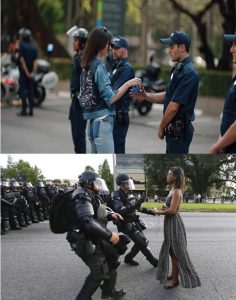Hasan Minhaj engaged with several of the common Islamic tropes throughout this episode of the Patriot Act. Towards the beginning of his talk, he brought up how Muhammad bin Salman was thought to “save the Arab world” as he lifted the law that prohibited women to drive. This moment in history was a big step for Muslim women in Saudi Arabia as Islam is known to fill the criteria of the uniquely sexist trope although, his humorous commentary downplayed it’s seriousness and showed how it really panned out. The video consisted of a Muslim woman rapping about knowing how to drive a car even though she was never physically driving it. He showed how this act is still frowned upon in their country and that Saudi women went so far as to protest the release of this legislation. Minhaj goes on to explain the war between Saudi Arabia and Yemen. He reveals that the praised reformer, Muhammad bin Salman, has been in fact funding the bombings on Yemen that have killed thousands, including those in schools and hospitals, and has driven Yemen’s famine to a level of crisis. Minhaj describes Salman to fit the trope that Islam is inherently violent very obviously, especially with his exaggerated facial expressions and body language when he makes jokes about how people could ever praise this scheming man. This dramatized way of telling the news is, in my opinion, effective as it keeps the audience engaged and also constantly rethinking since this casual approach allows the storyteller to say the things that others tend to shy away from on high profile news channels.
After saying his piece on Salman, he brings up several other unethical Indian individuals that are in a position of power in the United States. The description of these Muslim men plays on the idea of the trope that the “Muslim mind” is irrational. Minhaj sheds light on John Kapur, Dinesh D’Souza, and Bobby Jindal’s “psychopathic” tendencies as political figures in a hysterical manner. The way that Minhaj makes jokes about these Muslim men and how he ended with a comedic video showing Muslim children with tainted minds because of the actions of these figures gets a message across in a deceiving fashion. These men can have an impact on the lives of our youth through their irrational actions on broadcast TV, which can sometimes be disguised by mainstream news channels. Hasan Minhaj’s comedic news broadcasting provided evidence for these tropes through his speech as a way to communicate withi his audience. These tropes are common knowledge and when they are brought to life in a comedic way it can be easier for people to digest and discover the real issues through their laughter.


